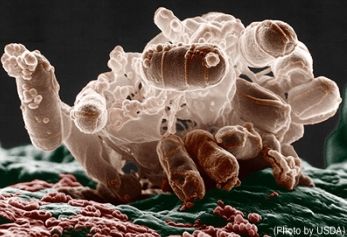What are Superbugs?

To understand superbugs, one must first understand bacteria. Bacteria are the most pervasive organisms on planet Earth. It is believed there are more than 5 nonillion (that is 5x1030) in existence. Therefore, bacteria are everywhere and are necessary to maintain all factions of balance in life. Scientists believe that bacteria are the original forms of life on the planet. Because of the form and structure of bacteria, it is difficult to date and study the evolution of fossilized bacteria. However, gene sequences allow researchers to assess whether its origins derived from a single celled organism or from a complex membrane-bound multicellular organism. What this information conveys is that bacteria are capable of evolving, rather aggressively in some circumstances. This is how superbugs are able to exist.
While not all bacteria are bad, that cannot be said about superbugs. The concern over superbug organisms is their ability to transmit disease and resist antibiotics, turning them into unstoppable forces of destruction. Their ability to stave off death from antibiotic treatments, tricks the body into believing it is a friendly organism and not foreign matter. This means that what started as a case of strep throat can turn into a life threatening illness in some circumstances. There are two particular strains of concern, carbapenem-resistant enterobacteriaceae (CRE) and methicillin-resistant Staphylococcus aureus (MRSA).
CRE is a cousin of E. coli. It is predominant in acute-care facilities that occupy a large number of compromised immune systems. The Centers for Disease Control and Prevention (CDC) have not been able to find any combination of antibiotics that consistently kills it, which raises the concern over CRE leap frogging from the sick to the healthy. How CRE came into existence is not precisely known. However, the CDC believes that it is the result of over-prescribing antibiotics directly to people, when not absolutely necessary.
Each year, MRSA kills more people than AIDS/HIV. In 1974, less than 2 percent of staph infections were caused by MRSA. In 1995 that total jumped to 22 percent and by 2007 that number climbed to 63 percent. The inescapable correlation between unnecessarily administering antibiotics within the agricultural factory farming industry and the rise in the percentage rates cannot be ignored. Even the United States Department of Agriculture (USDA) could not look away from the mounting evidence, and requested a scholarly report. However, the information contained within that report was so damaging that it managed to disappear soon after submission, because its existence affected the stock market. The 63-page summary clearly outlined that the large quantities of antibiotics given to healthy livestock, to both combat theoretical problems from severe maltreatment and quicken the fattening process, create perfect environments for MRSA to grow.
Chronic use of antibiotics in healthy animals kills off good bacteria. This allows aggressive negative bacterial growth to occur. Factory farms choose to overlook that problem for profit sake. Aggressive use of antibiotics allows factory farms to bring more animals to slaughter, with heavier meat quotients, in a shorter amount of time. Some of these over-medicated animals die from MRSA exposure. However, those animals that do not die turn into hosts. In short, the superbug remains active after slaughter and is stored inside the meat that people consume. The cooking process, regardless to the level of doneness, does not render MRSA inert. Hence, people consuming factory farm meats are ingesting the negative bacteria, which make them prone to antibiotic-resistant bacterial infections. Since children, the sick, and the elderly have extremely sensitive immune systems, they are most at risk for deadly infections.
Here is an uncomplicated way to process what a superbug does to the body. Think of CRE and MRSA as servants of the Borg (Star Trek: TNG, 1989). They are highly adaptable to rapidly changing environments in order to complete their mission, which is to dominate the body, assimilate the system, terminate the host, and spread to other life forms.
For those interested, support the Animal Legal Defense Fund (ALDF) by signing their Stop Factory Farm Animal Abuse petition.
While not all bacteria are bad, that cannot be said about superbugs. The concern over superbug organisms is their ability to transmit disease and resist antibiotics, turning them into unstoppable forces of destruction. Their ability to stave off death from antibiotic treatments, tricks the body into believing it is a friendly organism and not foreign matter. This means that what started as a case of strep throat can turn into a life threatening illness in some circumstances. There are two particular strains of concern, carbapenem-resistant enterobacteriaceae (CRE) and methicillin-resistant Staphylococcus aureus (MRSA).
CRE is a cousin of E. coli. It is predominant in acute-care facilities that occupy a large number of compromised immune systems. The Centers for Disease Control and Prevention (CDC) have not been able to find any combination of antibiotics that consistently kills it, which raises the concern over CRE leap frogging from the sick to the healthy. How CRE came into existence is not precisely known. However, the CDC believes that it is the result of over-prescribing antibiotics directly to people, when not absolutely necessary.
Each year, MRSA kills more people than AIDS/HIV. In 1974, less than 2 percent of staph infections were caused by MRSA. In 1995 that total jumped to 22 percent and by 2007 that number climbed to 63 percent. The inescapable correlation between unnecessarily administering antibiotics within the agricultural factory farming industry and the rise in the percentage rates cannot be ignored. Even the United States Department of Agriculture (USDA) could not look away from the mounting evidence, and requested a scholarly report. However, the information contained within that report was so damaging that it managed to disappear soon after submission, because its existence affected the stock market. The 63-page summary clearly outlined that the large quantities of antibiotics given to healthy livestock, to both combat theoretical problems from severe maltreatment and quicken the fattening process, create perfect environments for MRSA to grow.
Chronic use of antibiotics in healthy animals kills off good bacteria. This allows aggressive negative bacterial growth to occur. Factory farms choose to overlook that problem for profit sake. Aggressive use of antibiotics allows factory farms to bring more animals to slaughter, with heavier meat quotients, in a shorter amount of time. Some of these over-medicated animals die from MRSA exposure. However, those animals that do not die turn into hosts. In short, the superbug remains active after slaughter and is stored inside the meat that people consume. The cooking process, regardless to the level of doneness, does not render MRSA inert. Hence, people consuming factory farm meats are ingesting the negative bacteria, which make them prone to antibiotic-resistant bacterial infections. Since children, the sick, and the elderly have extremely sensitive immune systems, they are most at risk for deadly infections.
Here is an uncomplicated way to process what a superbug does to the body. Think of CRE and MRSA as servants of the Borg (Star Trek: TNG, 1989). They are highly adaptable to rapidly changing environments in order to complete their mission, which is to dominate the body, assimilate the system, terminate the host, and spread to other life forms.
For those interested, support the Animal Legal Defense Fund (ALDF) by signing their Stop Factory Farm Animal Abuse petition.
You Should Also Read:
How Factory Farms Degrade Livestock
United States Cattle Rejected
The Hazards of Frankenfish

Related Articles
Editor's Picks Articles
Top Ten Articles
Previous Features
Site Map
Follow @WildlifeWelfare
Tweet
Content copyright © 2023 by Deb Duxbury. All rights reserved.
This content was written by Deb Duxbury. If you wish to use this content in any manner, you need written permission. Contact Deb Duxbury for details.







